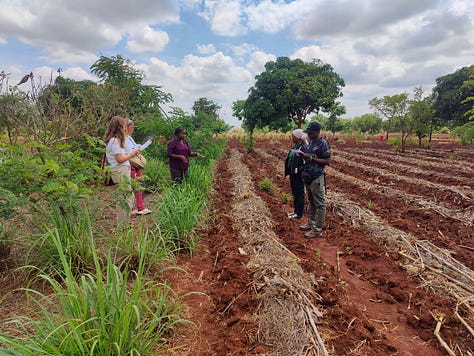Since being in Norway as a SEED participant I have learned a lot of things. Throughout the program I have been moving around Norway visiting Norwegian farmers. One of the things that I have learned during these farm visits is the differences in farming between Norway and Malawi, as well as the impacts of climate change on agriculture in the two countries.







Climate and agriculture are intricately linked. Malawi is gifted with fertile land, enough water, and enough sun. However, this is now under threat. Climate change is the greatest threat to Malawian agriculture. The Food and Agriculture Organization (FAO) states that Malawi’s economy sorely depends on agriculture and that the majority of Malawians are smallholder farmers. Statistics show that Malawi’s population is made up of over 19.1 million people, of which 80% of the population are smallholder subsistence farmers. Climate change has greatly affected these smallholder farmers in rural communities, who depend so much on stable seasons for their harvest. Adverse weather-related events in the form of droughts, flooding, and inconsistent rainfall, has led to food insecurity among many households. As of the 23rd of March 2024, the President of the Republic of Malawi, Dr. Lazarus Chakwera, declared a state of disaster in 23 out of the country's 28 districts. In those 23 districts around 2 million farming households have been affected by the El Nino-induced dry spells and are in desperate need of food. According to the president, Malawi urgently needs more than $200 million in humanitarian assistance to overcome the drought.








Norway is a mountainous country with a lot of water, but with a unique climate and soil that does not allow a lot of crops to grow. This is why only 3 percent of Norway’s total land area is farmed land, and only 1.7% of the population are farmers. Due to the climatic limitations, Norway is unable to grow crops like different fruits, and only a small part of the farmland is located in areas where climatic conditions are suitable for growing cereals for human consumption. Most of the fruits, berries and different foods consumed in Norway are imported. It’s grass-based livestock production that is the backbone of Norwegian agriculture. This explains why the dairy cow has become the most important agricultural product. The dairy cow is the basis for milk, meat and, together with grazing sheep, the up-keeping of the Norwegian agricultural landscape. A substantial part of the country’s home-grown grain is used as fodder due to crop quality. According to Irene and Roald farm, owners of one of the farms I visited, climate change impacts are also very real for them. However in Norway’s case it is increased heavy rainfall that impacts them, unlike drought in Malawi. These heavy rains cause major soil erosion, and given that their farm is hilly, this led to loss of fertility in the soil, which resulted in poor harvest of their pastures and less food for their animals.
Another difference that I have noticed between the two countries in terms of farming is the fact that Malawi grows all of the food that they consume, which means that drought affected harvests leave people with no food. They do not trade with neighboring countries, and imported food would be unaffordable for the majority of Malawians. Meanwhile in Norway they are used to not growing the majority of their own food, and are better set up with food imports, as well as most Norwegians being in the position of being able to afford imported food. For Norway it’s the food for their livestock that is at risk. Another difference is farming in Norway is a job. The government support farmers financially, depending on how big the farm is and how much livestock the farmer has, while in Malawi farming is an essential need for everyone, and a means of survival. If you don’t grow your own food in Malawi, you will simply not eat, and the government only partially supports smallholder farmers by providing fertilizer and seeds, and farmers still have to pay an amount. Another thing I have noticed is that in Norway almost all farmers use machines, while in Malawi it’s manual work, and because of this the crops yield are not enough.
Climate justice involves recognizing and addressing the unequal distribution of climate impacts, as well as the historical players responsible for accelerating climate change. It also involves recognizing the disproportionate ways climate change affects different countries and their people. Often, communities who have contributed the least to climate change, such as low-income countries like Malawi, are the ones affected the most. Although it was eye-opening for me to see a rich country like Norway also experience the effects. Hence, climate justice seeks solutions to the problem of climate change by advocating for policies and actions that prioritize the needs and rights of those most affected by climate change while also addressing its unfair impacts. I recognize climate justice in agriculture through having access to climate adaptation finances, and ensuring that farmers are more resilient in the face of a changing climate.
However, adaptation is not easily done, and it requires more support and funding. One of the most important measures to combat hunger and extreme poverty is climate financing that focuses on smallholder farmers, which would increase food security through helping farmers become more resilient. This is why the Norwegian government increase climate financing and invest in agroecology practices that would support smallholder farmers to enhance food security, while also prioritizing biodiversity. The government must support initiatives that empower small-scale farmers and indigenous communities in adopting sustainable agricultural practices, and also promote knowledge sharing and capacity building in sustainable agriculture.
Thank you for reading Malawi’s Call. I’m looking forward to sharing more of my journey with you.
Don’t forget to subscribe if you haven’t already!


